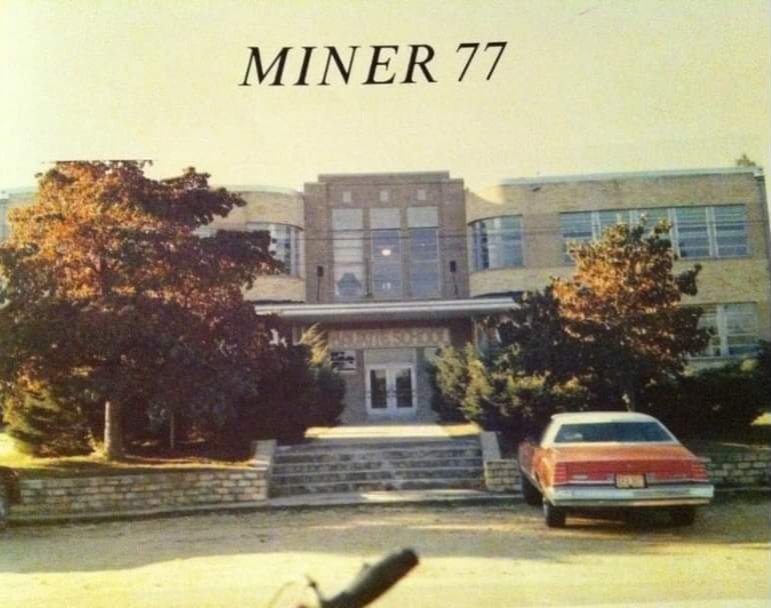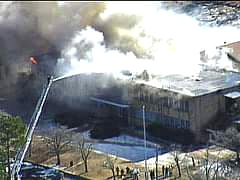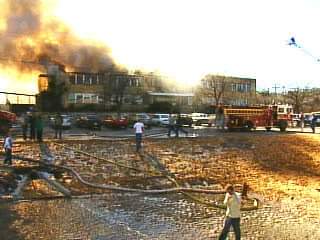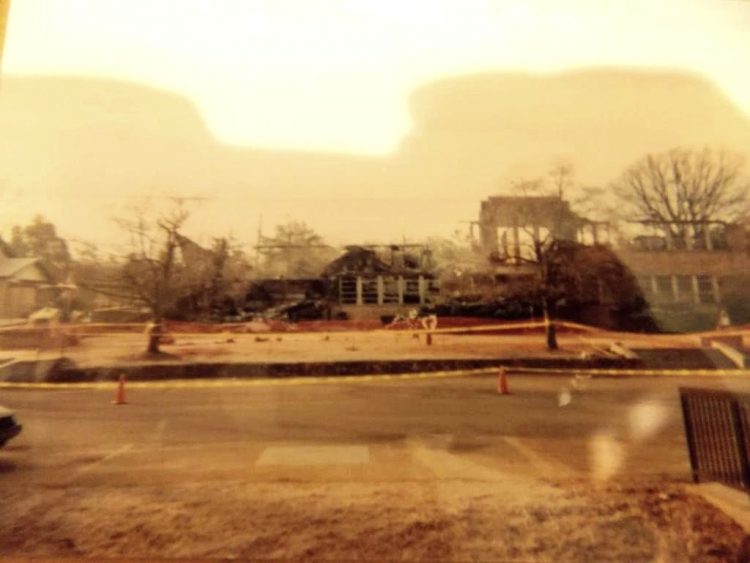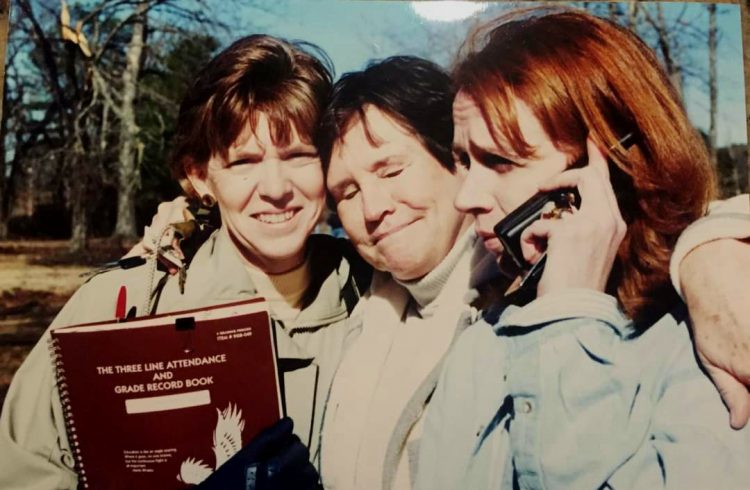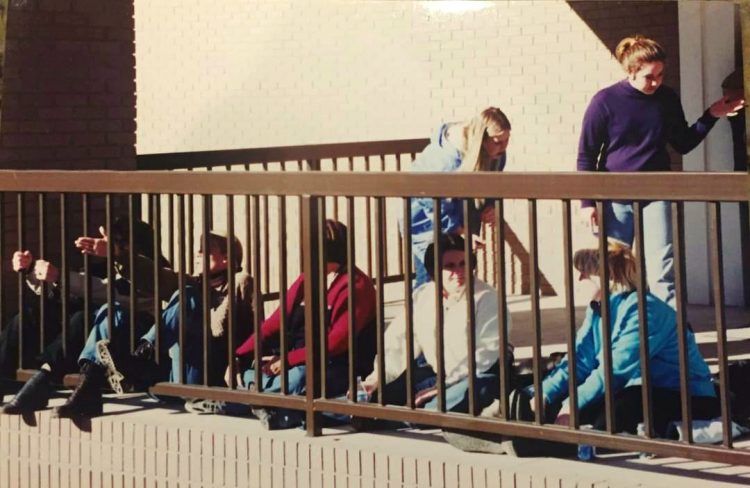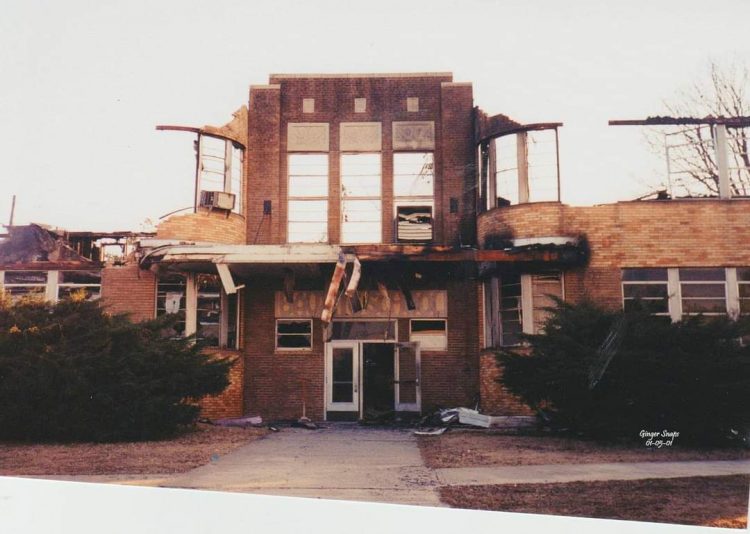This article is as told by Matthew Shepherd, a Social Studies teacher from Bauxite High School:
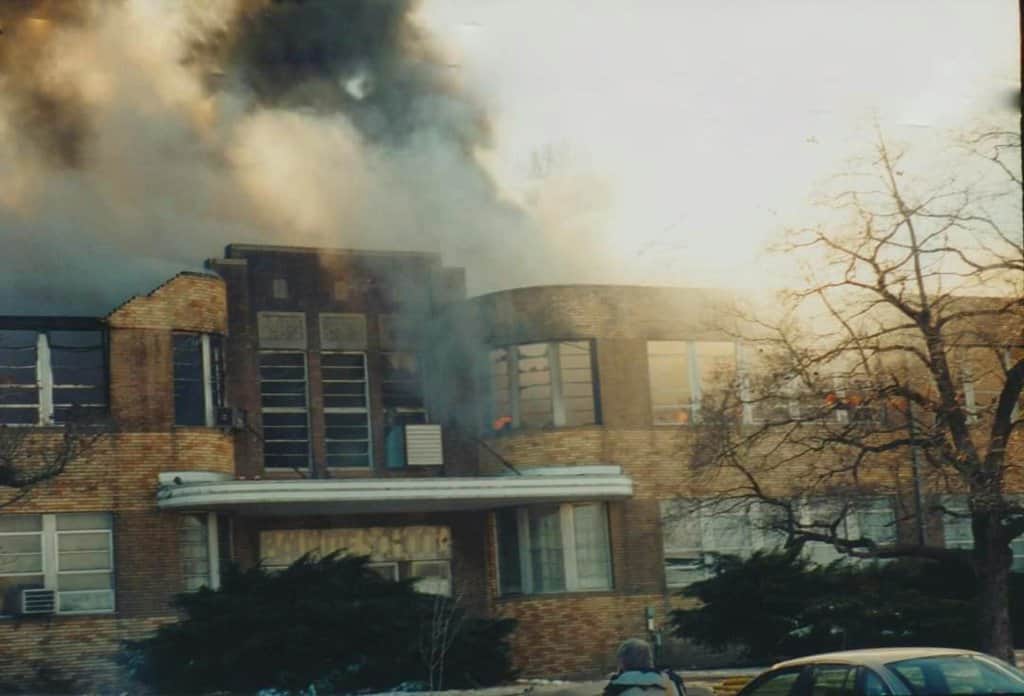
Bauxite High School burns on Jan. 5, 2001. Matthew Shepherd, a social studies teacher in his 22nd year at the rebuilt Bauxite High School, recalls the day the school burned. Read the story below, in his words, and look for more to come, in the Facebook group “Pick and Shovel.” Photo credits go to Linda Davidson, longtime art teacher and yearbook sponsor.
Tuesday, January 5, 2021, marks the 20th anniversary of the fire that destroyed the original Bauxite High School. I was 27, entering my second year as a teacher in the Bauxite School District, and was married for just over six months. This is a collection of my personal memories of that day.
In December of 2000 Arkansas was hit by back-to-back ice storms that crippled the state and forced Bauxite to close several days early for Christmas Break. The second ice storm, which hit Christmas Day 2000, was an underlying factor as to why the school burned down… but I’m getting ahead in the story.
School was supposed to resume from the Christmas Break on January 2, 2001. This didn’t happen for several reasons. The first factor for the delay was due to the extreme cold. It never got above 40 degrees for two weeks between Christmas and when school was supposed to resume. At night the temperatures would drop into the 20s resulting in refreezing on the roads. The second factor that led to the delay was the refreezing of the roads. At the time, Bauxite was a much more rural school district than it is today.
The Bauxite Cut-off, Highway 35, and Highway 190 into Tull were canopied by trees that inhibited the melting of the ice. What little ice did melt would just refreeze that night making it impossible to move buses safely. The final factor that led to the delay was a huge portion of our district, primarily the most rural areas, were without power due to the Christmas Day ice storm two weeks earlier.
My mother-in-law and father-in-law, Kenneth and Shirley Baxley, didn’t have power for 10 days after the storm, and for some people it wasn’t until mid-January. As a result of all of these factors, school resumed on Thursday, January 4th.
When school resumed, the principal, Mr. John Lowry, told us that semester exams – which had been scheduled before the first ice storm but were paused until we returned – would be the next week of school. As a result, I started reviewing with students in preparation for the exam and did that with most of my classes all day.
I don’t remember too much about what happened on January 4th EXCEPT that the bells were messed up because melting ice on the roof got into the lines and would cause the fire alarm to ring randomly throughout the day. The first time it happened, I called the office and they told me it was a false alarm. This would prove monumental and consequential the next day.
On Friday, January 5th, the school day began as all the others. I went to my room on the second floor. My class faced the front of the school. If you were to look at the façade of Bauxite High School, my room was the top floor, left side, in the curve of the building. As mentioned before, the bells were messed up. They rang at the wrong times, the fire alarm would ring at random intervals, or the bells wouldn’t ring at all.
These were the challenges of teaching a building that was over 60 years old. School started at 8:10 a.m. back then and I remember nothing of consequence about 1st or 2nd periods that morning. The one thing I do remember is that Mr. Lowry made an announcement that students weren’t to use one of the stairwells on the exterior of the building. I thought he said the one on the opposite end of the building from my room, but I later found out it was the one closest to my room. It was 3rd period when all heck broke loose.
I was teaching World History to 10th graders 3rd period. Around 10:15 a.m. that morning the fire alarm began ringing. As mentioned earlier, the fire alarm had been malfunctioning since we had returned. I had checked with the office the day before and they told me to just ignore it. So I did. After 5 minutes of non-stop ringing I stuck my head outside the door and that’s when black smoke, like the scene from the movie “Backdraft”, rolled in over my head.
At that point I may or may not have uttered something along the lines of “Oh ****” and “We Need to Get the **** out of Here!” to the students. I sent them on our pre-arranged escape route which went out of my door, to the left, and down the exterior stairwell closest to the newly constructed 7th grade building.
When I left the room, I turned left into a wall of thick black smoke. The distance from my door to the exterior was only 15 feet and the door was clear plexiglass. However, the smoke was so thick I couldn’t see outside.
I put my coat over my head and ran through the smoke and hit the door full speed launching myself outside on the icy steps. The exterior stairwell was “L-shaped,” meaning it came down the side of the building, had a flat space, then the remaining stairs went the opposite direction.
Mr. Lowry was on the flat part coming up checking all the doors to ensure the students were out of the building. He asked if anyone was left in the building and I told him no. I told him to call on the walkie-talkie and get maintenance to shut off the gas lines because we didn’t want explosions. Thankfully the maintenance staff had already done that.
I went to the front of the building when my sister-in-law, Trina Baxley,who was a school secretary at the time, told me that one of my fire marshals had gone back into the building. I dropped everything I had and actually ran back into the building where I ran face-to-face with Coach Jon Watson who was making sure classes were cleared and the bathrooms were empty. I asked if he had seen the student in question and he said “no.” We made the decision to exit the burning building. Coach Watson saved many trophies and other memorabilia from the trophy cases that day.
By this point we knew it was a real fire. However, we didn’t know the extent or damage. We could hear the volunteer fire trucks from all over the area coming to put the fire. When they finally arrived, many of us jumped in to help pull hoses and get things lined up with the hopes the fire would be contained and the damage minimal.
However, this is where the two plus weeks of freezing temperatures did its most damage. When the fire crews had gotten the hoses attached and they opened the lines all that happened was that water merely trickled out. The weather had frozen all the water lines to the fire hydrants. At that point, the fire crews had to start bringing in water from “blue holes” to contain the blaze. The task shifted from stopping the BHS fire to preventing it from spreading and taking out the newly constructed 7th grade building.
There are lots of rumors and stories as to why the fire began, but I won’t go into all of those. Here are a couple of my thoughts from that day:
1) After all the students were accounted for and the fire crews were attempting to contain the blaze, I remember sitting on the porch of the newly constructed Fred Dawson Gym with about 10 other teachers and we watched it burn. There was nothing we could do. It was maybe 30 degrees outside, but it wasn’t cold. The fire warmed us;
2) This is the day I realized cellphones were going to be a problem in schools. When the school was fully engulfed I looked at Trina Baxley and asked, “How are we going to get all these kids home without being able to call their parents?” Her response was, “I think they’ve got it taken care of.” I looked around and saw nearly EVERY kid talking on their phones; and
3) Most importantly, in less than five minutes, the faculty and staff evacuated 500 students ages 12-18 from BHS. Not a single student was injured and, most blessedly, there wasn’t any loss of life. God looked out over us that day.
In the weeks and months that followed, the original BHS was demolished and construction began on the current high school. Over the next few weeks/months, I plan to share some of the photos of the interim between the two high schools, along with the construction of the current BHS.
The pictures I’m posting were taken by Linda Davidson, the long term art teacher and yearbook sponsor, who had the foresight to take pictures on such a memorable day.



